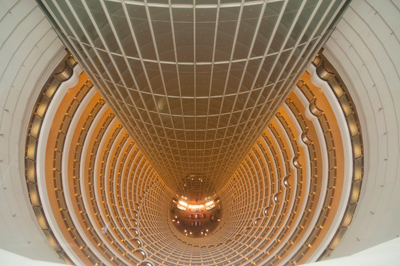Interiors are designed for people rather than photography. Natural light intensity may be inconveniently low, contrast can be excessive and space restricted. Human beings are extraordinarily well equipped to deal with these problems. Our eyes adapt rapidly to light and shade, and can easily handle a typical ten-stop range of brightness in normal interior conditions. We also have a wide field of view extended endlessly by our ability to move our eyes and heads. Cameras, sensors and films are much less sophisticated.
 If we are to photograph restricted environments of this type we must often employ a lens with a broad field of view to give a feeling of spaciousness. It is also important to show that the environment is a room rather than just a wall or corner. The fields of view of 16mm and 18mm lenses are likely to be about 180 and 100 degrees respectively, so these are the sorts of focal lengths we might consider using. Bear in mind that wide-angle lenses exaggerate perspective and appear to distort objects close to the edge of an image. It is therefore good practice to move furniture away from the camera and keep subjects within the central half of the frame.
If we are to photograph restricted environments of this type we must often employ a lens with a broad field of view to give a feeling of spaciousness. It is also important to show that the environment is a room rather than just a wall or corner. The fields of view of 16mm and 18mm lenses are likely to be about 180 and 100 degrees respectively, so these are the sorts of focal lengths we might consider using. Bear in mind that wide-angle lenses exaggerate perspective and appear to distort objects close to the edge of an image. It is therefore good practice to move furniture away from the camera and keep subjects within the central half of the frame.
The lighting found inside buildings varies enormously. Modern building may be illuminated primarily by daylight because windows are large, but may also utilize fluorescent lighting. Older buildings tend to have smaller windows and less natural light, and may rely upon numerous tungsten light sources. Mixed lighting is probably the most difficult because colour temperatures vary. A useful first step is therefore to establish the extent and nature of the lighting available.
Flash can be used to photograph even large interiors but setting up the numerous flashguns to achieve a balanced and atmospheric result is a highly skilled job. A surprisingly large number of powerful studio flash units may be required to illuminate large buildings such as churches and cathedrals. Such work consequently tends to be beyond the reach of amateur enthusiasts not least because it cannot be undertaken without the full co-operation of the building's management.
Whatever the nature of the interior being photographed, excessive contrast will be an ever-present problem. The lighting set-up must be designed to fill dark shadow areas and bring the whole scene within the dynamic range of the recording medium. Meter from evenly lit mid-tones and make sure that spot readings are obtained from all the areas which may prove problematic.






